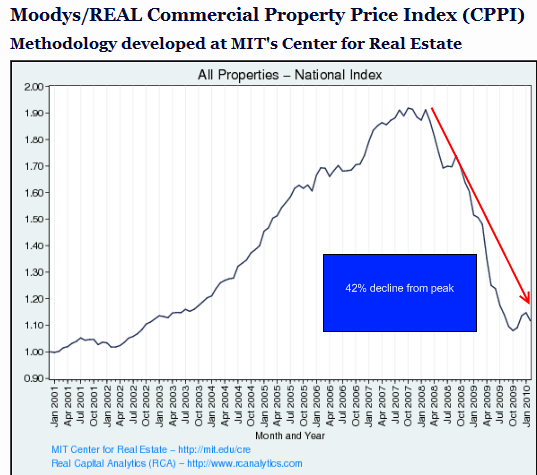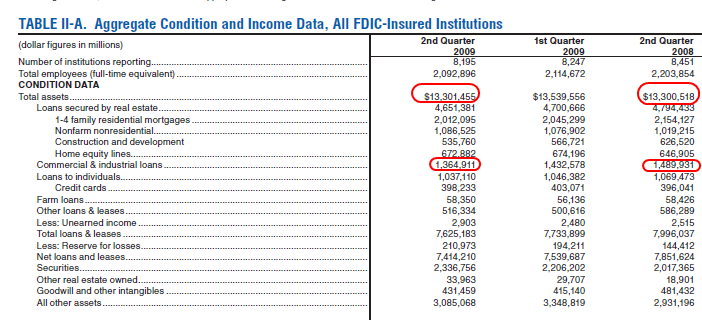Commercial real estate pushes $7.4 billion in FDIC Losses in one day – Hard to hear the CRE collapse with investment banks finally being called out in the court of public opinion. $3 trillion CRE market will keep Fridays busy for the FDIC.
- 1 Comment
The $3 trillion commercial real estate market is still in a state of economic turmoil. Many people might have missed the big news on Friday given the massive spotlight on Goldman Sachs. On Friday, the FDIC closed down 7 banks at a stunning cost of $7.4 billion to the FDIC. As we have mentioned, the FDIC deposit insurance fund (DIF) is already depleted yet the FDIC has front-loaded premiums to make sure they have a buffer to combat the continuing bank collapses. The Friday bank failures will cost the FDIC the most since the collapse of IndyMac almost two years ago. IndyMac collapsed because of toxic residential loans including option ARMs. Many of the banks collapsing now are deep in the commercial real estate game and that is the next thing to go bust.
Commercial real estate prices have fallen a stunning 42 percent from their peak only a few years ago:

Source:Â MIT
Unlike residential real estate that usually has a liquid market, many commercial real estate deals take years to put together. Many deals are developed in booming times (i.e., 2005) and only come online when things are completely bust (i.e., 2008). Many of the regional banks were unable to compete with Wall Street and the big GSE lenders for the residential market so they decided to dive in head first into the commercial real estate game. That proved to be an ill-timed bet.
The FDIC looks after 8,000 institutions with $13 trillion in combined assets:

Source:Â FDIC
Take a look at the construction and development line but also the commercial and industrial loan line. These are only a few places where those CRE deals show up. Banks are taking major hits on these deals because during the boom times, many businesses were assuming razor thin margins in the best of times and expecting credit to be easily available for a long time. Both those situations are no longer applicable today in the market. Credit is tight for commercial loans and the economy isn’t exactly in good shape outside of Wall Street.
And with CRE defaults, we are seeing some spectacular failures. This last week we heard that none other than the Ritz-Carlton in Tahoe has had a default notice filed against it:
“(WSJ) The developers of the Ritz-Carlton Highlands hotel at Lake Tahoe apparently have leaned a little too far over their skis. Bank of America Corp., the lead lender in the hotel’s $157 million mortgage, has filed a default notice against the property.
Developer and owner East West Partners, based in Avon, Colo.,  is “talking daily†with its lenders to resolve the situation, East West senior partner Blake Riva said. At issue: $10 million of the loan has matured without being paid, and the lenders want East West to pitch in another $8 million of capital.
Otherwise, East West and Ritz-Carlton, a unit of Marriott International Inc., say the hotel is doing well. Like many mountain-resort businesses, the Ritz is temporarily closed and slated to reopen by mid-May, after the “mud season†passes and vacationers return to the area on the California-Nevada border.â€
Short of not paying a few million, all is well. This is the kind of shell game going on in Wall Street that is allowing Bank of America to turn out billions of dollars in quarterly profits even though cash flow is drying up for many of their real estate deals. There is an enormous problem with CRE loans coming due yet many banks like they did with residential loans, are choosing to ignore missed payments and would rather pretend all is fine. In their current state of mind, they would rather pretend CRE values are up to $6 trillion nationwide instead of putting their value closer to what it truly is at $3 trillion. In other words, the entire market is close to being underwater on aggregate.
The giant defaults in CRE bring on two unique problems. For the CRE market, you have virtually no buyers (at least at current prices). Next, you have banks that are using mark to market to keep prices elevated even though many of these current CRE note holders are unable to even keep their loans current. So big banks on Wall Street would rather ignore the issue and keep using taxpayer money to spin out make believe profits. Yet regional banks don’t have the political pull and access to the U.S. Treasury and Federal Reserve and are finding out that they are largely insolvent. This is an issue of solvency, not liquidity.
Commercial real estate is also under more short-term refinancing windows (i.e., 5 or 7 years) so many loans are coming due in full. Unlike residential real estate with longer 30 year horizons, these loans must be paid in full or refinanced every few years. Now in more normal times, this isn’t such a problem because ideally the bank did its own due diligence before lending out billions and made sure the cash flow of the business could cover the loan. But in the last decade, the same easy financing that occurred in residential real estate occurred with commercial properties. So now, you have a major endgame. These properties do not qualify for financing and borrowers are unable to pay the bill. So the banks that can pretend continue to pretend and the other more regional banks are taken over by the FDIC. Clearly this two-tiered system cannot continue indefinitely.
These problems are not confined only to California:
“(Washington) Among the projects on the seriously troubled list is the nearly 400,000-square-foot Metro Center III office building at University Town Center in Hyattsville, according to bond data. The building’s outstanding $20.5 million loan is 11 months delinquent and the building owners have told lenders that they can no longer pay full debt service due to expiring leases and vacancy issues. The property, which counts Kaiser Permanente as a tenant, is about 60 percent occupied.
The Hyatt Regency in Bethesda is a recent newcomer to the delinquency list at 30 days delinquent on its $140 million loan that matures in January 2012. The hotel’s debt service coverage ratio is 1.18.
“I think the area will suffer more on a property-by-property basis,†Mancuso said. “Refinancing, that is the No. 1 challenge.â€
And the list goes on. The CRE shoe has dropped but we have our hands full dealing with crooked investment banks. When it rains it pours and we’ll have to learn to chew and walk at the same time because many issues are coming together at once after the Wall Street gambling spree.
If you enjoyed this post click here to subscribe to a complete feed and stay up to date with today’s challenging market!1 Comments on this post
Trackbacks
-
david said:
I have tried for six months to buy a restaurant owned by a bank. The bank is in such bad shape they were unable to counter my cash offer. They are using the old book value to prop up their balance sheet. I would have 40 new jobs by now if the bank was not underwater.
May 3rd, 2010 at 3:35 pm

 If you enjoyed this post click here to subscribe to a complete feed and stay up to date with today’s challenging market!
If you enjoyed this post click here to subscribe to a complete feed and stay up to date with today’s challenging market!